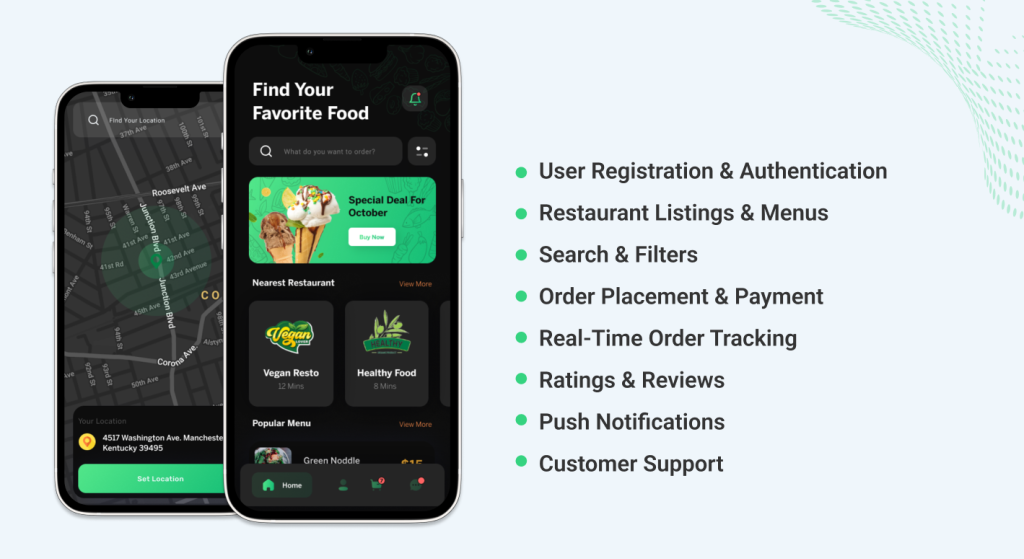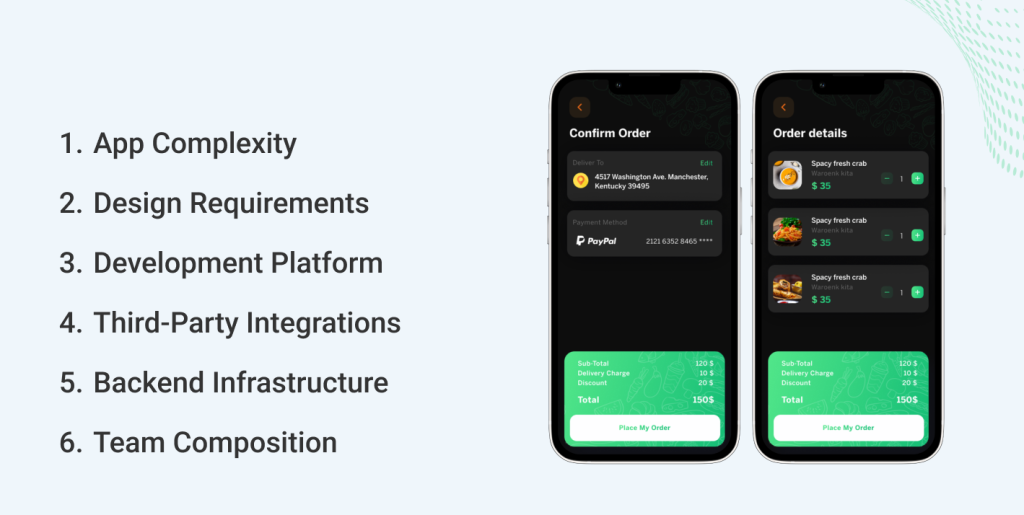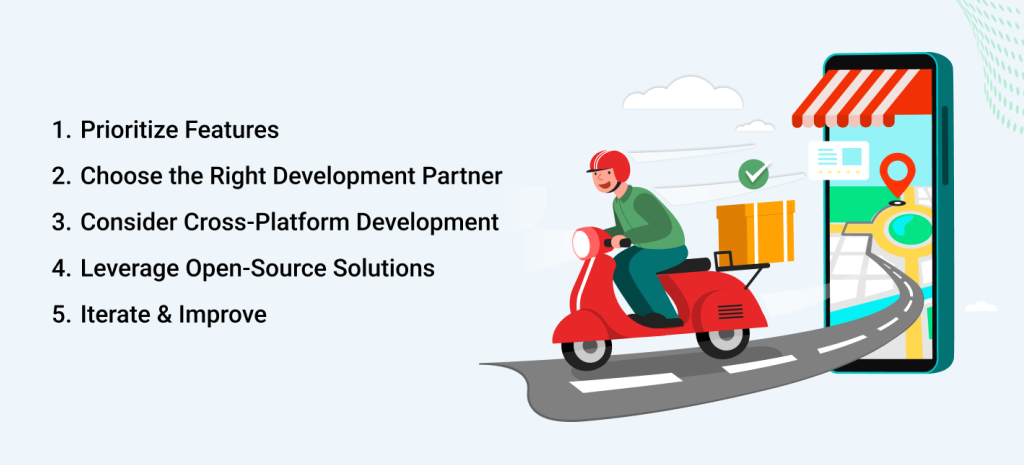The online food delivery industry is booming. In 2022, the global online food delivery market was valued at $137.9 billion and is expected to reach $210.3 billion by 2027. This growth is being driven by several factors, including the increasing popularity of mobile devices, the growing demand for convenience, and the rise of food delivery apps. But the question is what is the cost of developing a food delivery app like Swiggy or Zomato?
Restaurants have changed the way they operate and have adapted to a whole new look. Fast forward to the major success of online food delivery apps, which have given users a new way to order food they wish to without physically going to the restaurants.
Just like any other mobile app development project, online food delivery apps also involve a framework and costing. An online food ordering and delivery app has a ton of basic requirements to meet. The whole process of deciding and ordering food is neither constrained to one cuisine nor one restaurant. This is the reason why a food delivery app becomes a trawl through many restaurants, cuisines, and varied users.
Regardless of the demographic, a food delivery app must be created to instantly and efficiently deliver optimal performance. Customers always expect a fast and seamless experience. Food delivery apps like Zomato and Swiggy provide a convenient and comfortable experience for customers to order their desired food from the comfort of their homes. Users can effortlessly select their preferred restaurant and their desired dish. Enjoying the benefits of an all-inclusive app naturally comes at a certain cost.
Breaking down the costs is essential to helping you determine the Cost Of Developing A Food Delivery App Like Swiggy. In this blog, we will dive deep into the costs involved in developing a food delivery app, providing you with a clear understanding of the investment required.
From the development of the user interface and user experience to the backend infrastructure and integration of third-party services, many factors contribute to the overall cost. We’ll explore each aspect and highlight potential areas where you can optimize expenses.
Understanding the costs associated with developing a food delivery app is essential for entrepreneurs and businesses in the food industry. By having a comprehensive picture of the expenses involved, you can plan and budget effectively, ensuring a successful launch and operation of your app.
Stay tuned as we break down the costs and provide valuable insights that will help you build a food delivery app like Swiggy and Zomato without breaking the bank.
Key Features & Functionalities Of Food Delivery Apps

Food delivery apps like Swiggy and Zomato have become an integral part of our lives, offering convenience and variety at our fingertips. To understand the costs involved in developing a similar app, it’s crucial to first understand the key features and functionalities that make these apps successful.
01. User Registration and Authentication
Users should be able to create an account and log in securely, allowing them to access personalized features and track their orders.
02. Restaurant Listings and Menus
The app should display a comprehensive list of restaurants, along with their menus, allowing users to browse and choose from a wide range of options.
03. Search and Filters
A robust search functionality is essential, enabling users to find restaurants based on location, cuisine, ratings, and other preferences. Filters should be provided to narrow down the search results.
04. Order Placement and Payment
Users should be able to place orders seamlessly and make payments securely through various payment options, including credit/debit cards, digital wallets, and cash on delivery.
05. Real-time Order Tracking
Users should be able to track the status of their orders in real time, from the moment it is placed to the time it is delivered.
06. Ratings and Reviews
Users should have the ability to rate and review restaurants and delivery services, providing valuable feedback to improve the overall experience.
07. Push Notifications
The app should send timely notifications to keep users informed about order status, discounts, and promotions.
08. Customer Support
A robust customer support system should be in place to address any queries or issues users may have.
These are just some of the key features and functionalities that a food delivery app should have. Each of these features requires careful planning, development, and integration, contributing to the overall cost of the app.
Factors Influencing The Cost Of Developing A Food Delivery App Like Swiggy?

Several factors influence the cost of developing a food delivery app. Understanding these factors will help you assess the expenses involved more accurately.
01. App Complexity
The complexity of the app, including the number of features, integrations, and customizations required, significantly impacts the cost. The more complex the app, the higher the development cost.
02. Design Requirements
The user interface and user experience design play a crucial role in the success of a food delivery app. Customizing the app’s design, including branding elements and unique animations, can increase the overall cost.
03. Development Platform
The choice of development platform, such as iOS, Android, or cross-platform, can impact the cost. Developing multiple platforms requires additional resources and expertise, increasing the development cost.
04. Third-Party Integrations
Food delivery apps often integrate with third-party services, such as payment gateways, map services, and restaurant management systems. Each integration adds complexity and cost to the development process.
05. Backend Infrastructure
The backend infrastructure, including servers, databases, and APIs, is essential for the smooth functioning of the app. Developing a scalable and robust backend infrastructure requires investment in resources and technologies.
06. Team Composition
The size and composition of the development team impact the cost. Hiring experienced developers, designers, QA testers, and project managers adds to the overall cost of development.
These factors, along with others, contribute to the total cost of developing a food delivery app like Swiggy. It’s essential to consider these factors and prioritize them based on your specific requirements and budget.
Let’s dig into the various factors to consider while building a food delivery app.
The Design Phase
The design phase is crucial for creating an intuitive and visually appealing food delivery app.
01. User Interface Design
Designing the app’s user interface involves creating wireframes, mockups, and prototypes. The cost depends on the complexity of the design, the number of screens, and the level of customization required.
02. User Experience Design
User experience design focuses on creating a seamless and enjoyable user journey. The cost of UX design depends on the complexity of user flows and the level of personalization required.
03. Branding and Visual Identity
Customizing the app’s branding elements, and developing a unique brand identity and visual assets, including logos, icons, and illustrations.
Investing in a well-thought-out and visually appealing design is essential for attracting and retaining users. The app’s overall look and feel are crucial for creating a memorable and engaging user experience.
Development Phase
The development phase is a crucial stage in building a food delivery app. It involves turning the app concept into a fully functional product. Let’s break down the factors associated with the development phase.
01. Frontend & Backend Development
The frontend development involves creating the user interface and implementing the app’s features and functionalities. Building a robust backend infrastructure involves creating APIs, setting up servers, and integrating with third-party services. The cost of backend development depends on the complexity and scalability requirements of the app.
02. Database Development
Developing a database for a food delivery app involves storing user information, order details, and restaurant data. The choice of database technology and the complexity of data structures can become factors that influence the cost.
03. API Integration
Integrating with third-party services, such as payment gateways and map services, requires additional development effort. The cost depends on the number of integrations and the complexity of the APIs.
The development phase is a significant investment, as it lays the foundation for the app’s functionality and performance. Allocating resources effectively and working with an experienced development team can help optimize costs during this phase.
Testing and Quality Assurance Phase
The testing and quality assurance phase ensures that the food delivery app functions flawlessly and meets the highest standards. Let’s break down the costs associated with this phase.
01. Functional Testing
Functional testing involves verifying that each feature and functionality of the app works as intended. The cost depends on the number of test cases and the complexity of the app’s features.
02. Compatibility Testing
Compatibility testing ensures that the app works seamlessly across different devices, operating systems, and screen sizes. The cost depends on the number of devices and configurations to be tested.
03. Performance Testing
Performance testing evaluates the app’s speed, responsiveness, and resource usage under different scenarios. The cost depends on the complexity of the app and the number of performance benchmarks.
04. Security Testing
Security testing identifies and addresses vulnerabilities to protect user data and ensure app security. The cost depends on the level of security required and the complexity of the app’s architecture.
Thorough testing and quality assurance are essential for delivering a reliable and user-friendly food delivery app. While the costs associated with this phase may seem high, they are necessary to ensure a seamless user experience.
Cost Breakdown: Maintenance And Updates
Launching the food delivery app is just the beginning. Ongoing maintenance and updates are crucial for keeping the app up-to-date and resolving any issues that arise. Let’s break down the costs associated with maintenance and updates.
01. Bug Fixes and Issue Resolution
Addressing user-reported bugs and issues requires continuous monitoring and development effort. The cost depends on the frequency and complexity of bug fixes.
02. Feature Enhancements and Updates
Adding new features and enhancing existing ones helps keep the app competitive and relevant. The cost of feature enhancements depends on the complexity and scope of the updates.
03. Server and Database Maintenance
Regular server and database maintenance ensures the app’s performance and data security. The cost depends on the size and complexity of the app’s infrastructure.
Investing in ongoing maintenance and updates is essential for the long-term success of your food delivery app. Allocating a budget for these activities will help ensure the app continues to meet user expectations and evolves with changing market trends.
Additional Costs To Consider
In addition to the development, design, testing, and maintenance costs, there are a few additional expenses to consider when developing a food delivery app.
01. Hosting and Infrastructure
The cost of hosting the app on servers and maintaining the necessary infrastructure should be factored into the budget.
02. Security and Compliance
Implementing security measures and complying with data protection regulations may require additional investment.
03. Marketing and Promotion
Promoting the app through various channels, such as digital marketing, influencer partnerships, and app store optimization, can help attract users. The cost of marketing and promotion should be considered to ensure the app reaches its target audience effectively.
By considering these additional costs upfront, you can allocate the necessary budget and avoid any surprises down the line.
How To Minimize Costs While Developing A Food Delivery App?

While developing a food delivery app involves a significant investment, there are several strategies you can employ to minimize costs without compromising on quality. Here are a few tips:
01. Prioritize Features
Focus on developing core features that are essential for the app’s functionality. This allows you to launch a minimum viable product (MVP) and gather user feedback before investing in additional features.
02. Choose the Right Development Partner
Working with an experienced development team that understands your vision and requirements can help optimize costs. They can provide valuable insights, suggest cost-effective solutions, and ensure efficient development.
03. Consider Cross-Platform Development
Developing the app for multiple platforms using cross-platform frameworks can save time and resources. This approach allows you to reach a wider audience without developing separate apps for each platform.
04. Leverage Open-Source Solutions
Utilize open-source libraries and frameworks to speed up development and reduce costs. However, ensure that the chosen solutions are reliable and secure.
05. Iterate and Improve
Launching an MVP and collecting user feedback allows you to iterate and improve the app based on real-world usage. This iterative approach minimizes the risk of investing in unnecessary features upfront.
By implementing these strategies, you can develop a cost-effective food delivery app without compromising on quality and user experience.
Four Stakeholders of The Food Delivery System

Creating an on-demand food application entails more than just a business model – it involves orchestrating a multitude of crucial components. The application is structured around four distinct stakeholders, each contributing vital elements to the app’s development.
To ensure a comprehensive application, we need to address the specific features for each stakeholder:
Admin Side
- Admin Login
- Payment management
- Restaurant management
- Application management
- Coupons and discount offer management
Customer Side
- Customer Login
- Menu Search
- Placing Orders
- Tracking Orders
- Application Filters
- Rewards and Discounts
- Customer Support Services
- Integration of Payment Gateway
- Providing Reviews and Ratings
Restaurant Side
- Restaurant Log-in
- Menu Control
- Push Notifications
- Checking Ratings and Reviews
Delivery
- Registration
- Order Supervision
- Order Status Updates
Final Thoughts On The Cost Of Developing A Food Delivery App Like Swiggy?
Developing a food delivery app like Swiggy and Zomato requires a significant investment, but understanding the costs involved is crucial for effective planning and budgeting. By breaking down the costs into development, design, testing, maintenance, and additional expenses, you can gain a comprehensive understanding of the investment required.
Choose Aipxperts As Your Food Delivery App Development Partner!
Remember, prioritizing features, choosing the right development partner, and leveraging cost-effective strategies can help minimize costs without compromising on quality. With careful planning and execution, you can build a successful food delivery app that delights users and drives your business forward.
At Aipxperts, we pride ourselves on our extensive experience in developing on-demand food delivery apps similar to Swiggy and Zomato. With a proven track record, we have successfully brought numerous food delivery app ideas to life. When it comes to creating a food delivery app while minimizing costs, partnering with us is the smart choice. Our in-depth understanding of the app development process enables us to strategically allocate resources, optimize development workflows, and employ cost-effective strategies.
With us by your side, you’re not just receiving a development team; you’re gaining a dedicated partner committed to crafting a high-quality food delivery app that meets your budget and aligns with your vision. We know how to strike the perfect balance between cost efficiency and delivering a top-notch user experience.
Take a look at our portfolio here.
Cost Of Developing A Food Delivery App Like Swiggy? | Hire experienced developers to develop food delivery apps from Aipxperts. Contact us for project estimates and enjoy a 15-day risk-free trial period.











